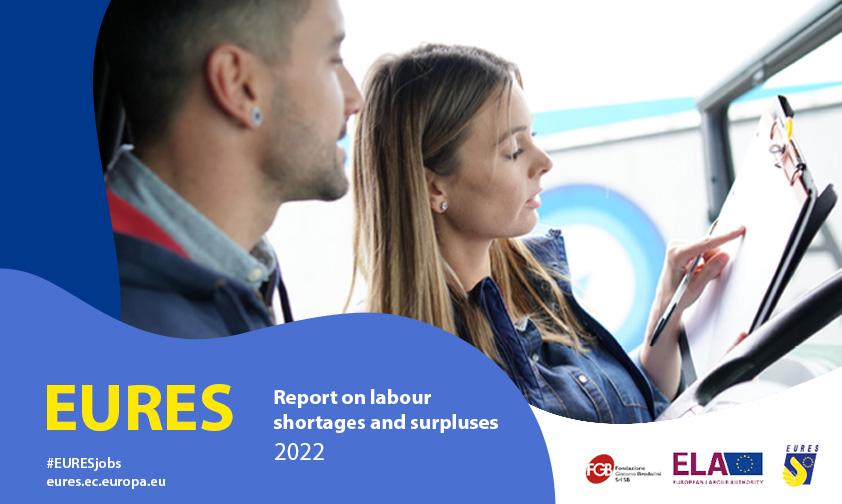Labour shortages in Europe – is the labour market tightening?

Where are the shortages, where are the workers? The drivers behind labour shortages in Europe and how to tackle them is a hot topic at the centre of two reports produced by the European Labour Authority (ELA) and by the European Foundation for the Improvement of Living and Working Conditions (Eurofound), to be launched on 29 March 2023 in Brussels.
The EURES Report on labour shortages and surpluses 2022, by the European Labour Authority provides details on labour shortages and surpluses such as their extent and severity in the EU27 plus Norway and Switzerland. Furthermore, the report contains insights on the drivers of shortages and surpluses, such as new technologies, the transition to a climate-neutral economy, the ageing of the workforce and conditions of work and employment.
The most widespread shortages occupations are in software, healthcare, construction and engineering crafts, whereas the greatest surpluses occur in clerical related occupations, elementary and professional occupations in the humanities and in the arts.
| Top 10 shortages occupations | Top 10 surpluses occupations |
| Bricklayers and related workers | Graphic and multi-media designers |
| Carpenters and joiners | Administrative and executive secretaries |
| Heavy truck and lorry drivers | General office clerks |
| Metal working machine tool setters and operators | Shop sales assistants |
| Nursing professionals | Secretaries |
| Plumbers and pipe fitters | Interior designers and decorators |
| Building and related electricians | Journalists |
| Welders and flame cutters | Elementary workers not elsewhere classified |
| Concrete placers, concrete finishers and related workers | Car, taxi and van drivers |
| Sheet metal workers | Photographers |
Source: Analysis of data submitted by EURES National Coordination Offices
Background for the 2022 labour market trend
A series of shocks have shaken the European economy over a short period between 2008 and 2020. After a prolonged growth, following the financial crisis in 2008, Europe’s economy and labour market suffered in 2020 a precipitous fall, with Covid-19. The real GDP fell by 6.1% in just one year, as a result of the economic lockdowns happening during the pandemic. Inactivity rates rose slightly during the pandemic, indicating that some people may have withdrawn from the labour market during the pandemic but inactivity rates have returned to their pre-pandemic levels during 2022.
One of the most striking findings from the report is the magnitude of the current imbalance between labour demand and labour supply in Europe. Almost 400 different occupations were classified by at least one country as a shortage, while 321 different occupations were identified by at least one country as a surplus. There are 38 specific occupations which are classified in the report as widespread shortages. The 38 shortage occupations were dominated by three groups of occupations; craft occupations; healthcare occupations, and occupations related to software.
There were 37 specific occupations which were classified in the report as widespread surplus occupations.
Why the report?
In its role of the European Coordination Office of EURES, ELA has a legal mandate to facilitate the provision of information on labour shortages and surpluses and so produces this report on annual basis.
The current 2022 report goes beyond previous editions, by including a more intensive focus on the impact of labour imbalances in Europe on vulnerable groups, and by providing an exploration of the factors which give rise to labour imbalances in Europe.
The quantitative analysis is based on a questionnaire circulated to EURES National Coordination Offices (NCO) of all 31 EURES network participating countries, to obtain the primary source for labour imbalances as presented in this report. Additional sources used are data extracted from the European Labour Force (LFS) database; CEDEFOP forecasts and national data sources.
The qualitative analysis, which explores the context in which labour imbalances emerge, consisted of a literature review focused on the causes of labour imbalances. Information was then triangulated with findings derived from three focus group meetings targeted to NCOs. An additional (qualitative) questionnaire was circulated to this group of representatives of the 31 countries, seeking their views on a number of issues relating to labour imbalances – particularly the impact of regionalisation and cross-border movements on labour imbalances.
For More Information
The report will be available to order on the Publications Office of the European Union website, at https://op.europa.eu/en/home as well as in the European Labour Authority website at Labour shortages report 2022 - EURES | European Labour Authority
ELA press contact:
Pia FALLSTROM MUJKIC, communication@ela.europa.eu
Resources
- Download the report | pdf
- Browse data on EURES dashboard
- Where are the shortages, where are the workers? | Launch event 29th March
- EURES Report on labour shortages and surpluses 2022 | Report webpage